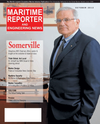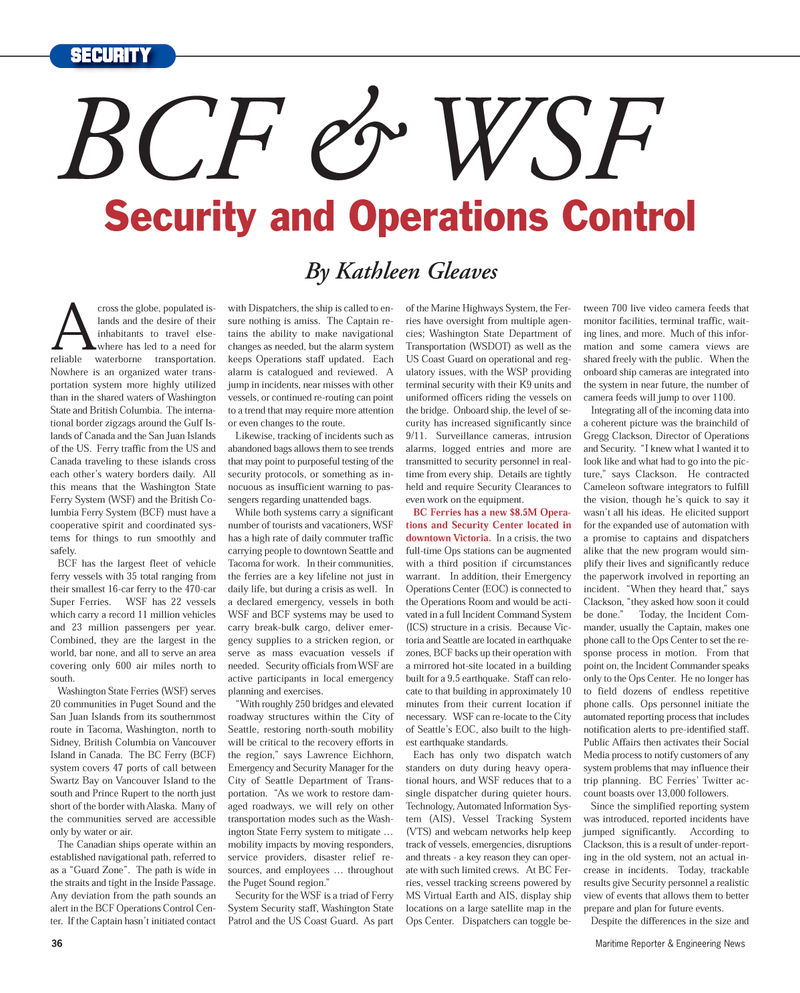
Page 36: of Maritime Reporter Magazine (October 2012)
Marine Design & Construction
Read this page in Pdf, Flash or Html5 edition of October 2012 Maritime Reporter Magazine
36Maritime Reporter & Engineering News Across the globe, populated is-lands and the desire of theirinhabitants to travel else- where has led to a need forreliable waterborne transportation. Nowhere is an organized water trans- portation system more highly utilizedthan in the shared waters of Washington State and British Columbia. The interna- tional border zigzags around the Gulf Is-lands of Canada and the San Juan Islandsof the US. Ferry traffic from the US and Canada traveling to these islands cross each other?s watery borders daily. All this means that the Washington State Ferry System (WSF) and the British Co-lumbia Ferry System (BCF) must have a cooperative spirit and coordinated sys- tems for things to run smoothly andsafely. BCF has the largest fleet of vehicle ferry vessels with 35 total ranging from their smallest 16-car ferry to the 470-carSuper Ferries. WSF has 22 vessels which carry a record 11 million vehicles and 23 million passengers per year. Combined, they are the largest in the world, bar none, and all to serve an area covering only 600 air miles north to south.Washington State Ferries (WSF) serves 20 communities in Puget Sound and theSan Juan Islands from its southernmostroute in Tacoma, Washington, north to Sidney, British Columbia on Vancouver Island in Canada. The BC Ferry (BCF) system covers 47 ports of call between Swartz Bay on Vancouver Island to the south and Prince Rupert to the north justshort of the border with Alaska. Many of the communities served are accessible only by water or air. The Canadian ships operate within anestablished navigational path, referred to as a ?Guard Zone?. The path is wide in the straits and tight in the Inside Passage. Any deviation from the path sounds an alert in the BCF Operations Control Cen-ter. If the Captain hasn?t initiated contact with Dispatchers, the ship is called to en-sure nothing is amiss. The Captain re- tains the ability to make navigational changes as needed, but the alarm system keeps Operations staff updated. Each alarm is catalogued and reviewed. A jump in incidents, near misses with othervessels, or continued re-routing can point to a trend that may require more attentionor even changes to the route. Likewise, tracking of incidents such as abandoned bags allows them to see trends that may point to purposeful testing of thesecurity protocols, or something as in-nocuous as insufficient warning to pas- sengers regarding unattended bags. While both systems carry a significant number of tourists and vacationers, WSF has a high rate of daily commuter traffic carrying people to downtown Seattle and Tacoma for work. In their communities, the ferries are a key lifeline not just in daily life, but during a crisis as well. In a declared emergency, vessels in both WSF and BCF systems may be used tocarry break-bulk cargo, deliver emer- gency supplies to a stricken region, or serve as mass evacuation vessels if needed. Security officials from WSF are active participants in local emergency planning and exercises. ?With roughly 250 bridges and elevated roadway structures within the City of Seattle, restoring north-south mobilitywill be critical to the recovery efforts in the region,? says Lawrence Eichhorn, Emergency and Security Manager for the City of Seattle Department of Trans- portation. ?As we work to restore dam- aged roadways, we will rely on other transportation modes such as the Wash- ington State Ferry system to mitigate ? mobility impacts by moving responders, service providers, disaster relief re- sources, and employees ? throughout the Puget Sound region.? Security for the WSF is a triad of Ferry System Security staff, Washington State Patrol and the US Coast Guard. As part of the Marine Highways System, the Fer- ries have oversight from multiple agen- cies; Washington State Department of Transportation (WSDOT) as well as the US Coast Guard on operational and reg- ulatory issues, with the WSP providing terminal security with their K9 units anduniformed officers riding the vessels on the bridge. Onboard ship, the level of se- curity has increased significantly since 9/11. Surveillance cameras, intrusion alarms, logged entries and more aretransmitted to security personnel in real-time from every ship. Details are tightly held and require Security Clearances toeven work on the equipment. BC Ferries has a new $8.5M Opera- tions and Security Center located indowntown Victoria. In a crisis, the two full-time Ops stations can be augmentedwith a third position if circumstanceswarrant. In addition, their Emergency Operations Center (EOC) is connected tothe Operations Room and would be acti- vated in a full Incident Command System (ICS) structure in a crisis. Because Vic- toria and Seattle are located in earthquake zones, BCF backs up their operation witha mirrored hot-site located in a building built for a 9.5 earthquake. Staff can relo- cate to that building in approximately 10 minutes from their current location ifnecessary. WSF can re-locate to the City of Seattle?s EOC, also built to the high- est earthquake standards. Each has only two dispatch watch standers on duty during heavy opera- tional hours, and WSF reduces that to a single dispatcher during quieter hours.Technology, Automated Information Sys- tem (AIS), Vessel Tracking System (VTS) and webcam networks help keep track of vessels, emergencies, disruptions and threats - a key reason they can oper- ate with such limited crews. At BC Fer- ries, vessel tracking screens powered by MS Virtual Earth and AIS, display ship locations on a large satellite map in the Ops Center. Dispatchers can toggle be- tween 700 live video camera feeds that monitor facilities, terminal traffic, wait- ing lines, and more. Much of this infor- mation and some camera views are shared freely with the public. When the onboard ship cameras are integrated into the system in near future, the number ofcamera feeds will jump to over 1100. Integrating all of the incoming data into a coherent picture was the brainchild of Gregg Clackson, Director of Operations and Security. ?I knew what I wanted it to look like and what had to go into the pic- ture,? says Clackson. He contracted Cameleon software integrators to fulfill the vision, though he?s quick to say it wasn?t all his ideas. He elicited support for the expanded use of automation with a promise to captains and dispatchersalike that the new program would sim- plify their lives and significantly reduce the paperwork involved in reporting an incident. ?When they heard that,? says Clackson, ?they asked how soon it could be done.? Today, the Incident Com- mander, usually the Captain, makes one phone call to the Ops Center to set the re-sponse process in motion. From thatpoint on, the Incident Commander speaksonly to the Ops Center. He no longer has to field dozens of endless repetitive phone calls. Ops personnel initiate theautomated reporting process that includesnotification alerts to pre-identified staff. Public Affairs then activates their Social Media process to notify customers of any system problems that may influence theirtrip planning. BC Ferries? Twitter ac- count boasts over 13,000 followers. Since the simplified reporting system was introduced, reported incidents have jumped significantly. According to Clackson, this is a result of under-report- ing in the old system, not an actual in-crease in incidents. Today, trackable results give Security personnel a realistic view of events that allows them to better prepare and plan for future events. Despite the differences in the size and SecurityBCF & WSF Security and Operations Control By Kathleen Gleaves MR#10 (34-41):MR Template 10/4/2012 10:58 AM Page 36

 35
35

 37
37
